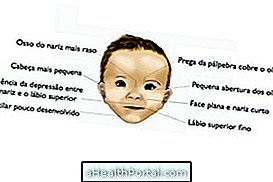Intellectual deficiency corresponds to the delay in the cognitive development of some children that can be perceived by learning difficulty, little interaction with other people and inability to perform simple and adequate activities for their age.
Intellectual disability, also called ID, is a developmental disorder that affects about 2 to 3 percent of children and can occur due to a variety of situations, from complications during pregnancy or childbirth to genetic changes such as Down's Syndrome and the X-Fragile Syndrome, for example. Find out what are the characteristics of X-fragile syndrome.
This disorder can be perceived by the parents or the teacher in the school, however, the treatment must be done by a multidisciplinary team with the purpose of stimulating all the cognitive functions, favoring the process of learning and relationship with other people. Thus, it is important that the child has direct and constant follow-up of the pediatrician, speech therapist, pedagogue and psychotherapist, for example.

How to identify
It is possible to identify the intellectual deficiency by observing the behavior of the child in the day to day. Usually it does not exhibit the same behavior as other children of the same age, it is always necessary for an adult or an older child to be around to assist in the performance of some action, for example.
Usually children with intellectual disabilities have:
- Difficulty in learning and understanding;
- Difficulty adapting to any environment;
- Lack of interest in day-to-day activities;
- Isolation from family, colleagues or teacher, for example;
- Difficulty of coordination and concentration.
In addition, it is possible that the child has changes in appetite, excessive fear and is unable to perform activities that he previously had.
Main causes
The most common cause of intellectual disability is genetic disorders such as Down syndrome, X-fragile, Prader-Willi, Angelman and Williams, for example. All these syndromes happen due to mutations in the DNA, and can result, among other symptoms, in intellectual deficiency. Other causes of intellectual disability are:
- Prenatal complications, such as gestation, gestational diabetes, drug use, smoking, alcoholism, drug use, and infections, such as syphilis, rubella, and toxoplasmosis;
- Perinatal complications that occur from the onset of labor until the first month of life of the baby, such as decreased oxygen supply to the brain, malnutrition, prematurity, low birth weight and severe newborn jaundice;
- Malnutrition and severe dehydration, which can happen until the end of adolescence and lead to intellectual disability;
- Poisoning or intoxication by drugs or heavy metals;
- Infections during childhood that can lead to neuronal impairment, decreasing cognitive ability, such as meningitis, for example;
- Situations that decrease the supply of oxygen to the brain, which can result in intellectual disability. Know the main causes of hypoxia in the brain.
In addition to these causes, intellectual disability can occur in innate errors of metabolism, which are genetic alterations that can occur in the child's metabolism and lead to the development of some diseases, such as congenital hypothyroidism and phenylketonuria. Understand better what phenylketonuria is.
What to do
If a diagnosis of intellectual disability is made, it is important that the child's cognitive and intellectual capacities are frequently stimulated and a multiprofessional team is important.
At school, for example, it is important for teachers to understand the student's need for difficulty and to develop a specific curriculum for the child. In addition, it is important to keep it integrated and stimulating your contact and interaction with others, which can be done by means of board games, puzzle and mime, for example. This activity, in addition to promoting social contact, allows the child to become more focused, which makes him learn a little faster.
It is also important that the teacher respect the child's learning pace, returning to easier subjects or activities if necessary. During the process of stimulating learning, it is interesting that the teacher identifies how the child best assimilates the information and contents, either through visual or auditory stimuli, for example, and it is then possible to establish an education plan based on the best response of child.
























